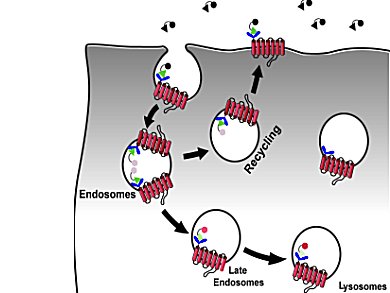Marcel P. Bruchez, Carnegie Mellon University, Pittsburgh, PA, USA, and colleagues demonstrate a genetically targeted surfaceselective pH biosensor that is useful for dynamic analysis of endosomal trafficking and antigen processing. This sensor is based on a genetically targeted fluorogen linked to a pH sensitive dye that undergoes a significant change in Förster resonant energy transfer (FRET) efficiency in response to environmental pH changes.
The sensor was used to analyze agonist-dependent internalization of ß2-adrenergic receptor (see scheme). It was also used as a surrogate antigen to reveal direct surface-to-endosome antigen transfer between dendritic cells (not shown).
The pH biosensor concept demonstrated can be extended to a range of different indicators. Dyes that display a change in quantum yield, spectral properties, or extinction coefficient can be converted into targeted sensors that modulate the energy-transfer efficiency in response to analytes. Dyes can be made cell permeable, and cells can be treated to allow dye incorporation.
Unlike direct fluorescent labeling, the fluorogen biosensor dye does not have to be washed away to reduce the background signal. This represents a significant new class of targeted biosensors for measuring local changes in the cellular environment.
- Genetically Encoded pH Sensor for Tracking Surface Proteins through Endocytosis,
Anmol Grover, Brigitte F. Schmidt, Russell D. Salter, Simon C. Watkins, Alan S. Waggoner, Marcel P. Bruchez,
Angew. Chem. Int. Ed. 2012, 51.
DOI: 10.1002/anie.201108107




